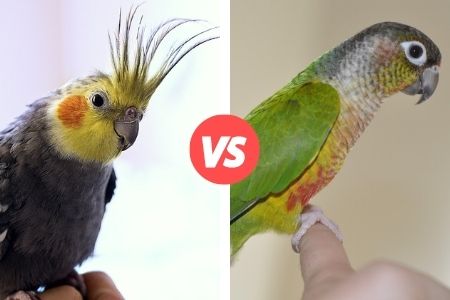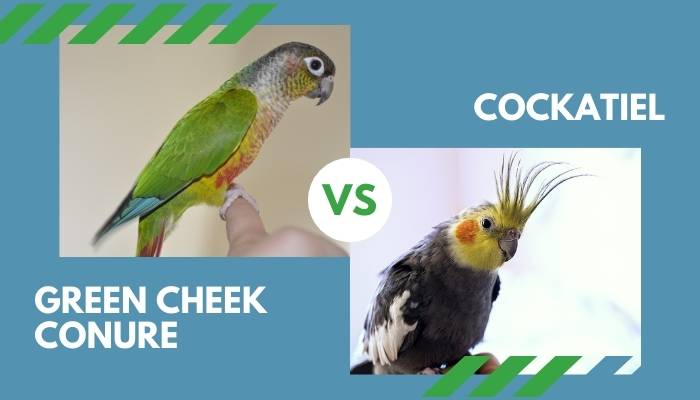Cockatiels and Green Cheek Conures are both friendly birds and excellent pets. Further, these two are also a bit on the gentler side. While they both belong to the same parrot family, certain things differentiate them from each other. Most of the difference lies in appearance, but there are different sides of things you should consider.
This article may help if you plan to get a pet bird but find it challenging to choose which one between the two.
Here, you will find some useful points which will help you choose between these two birds.
Without further ado, let’s get into it!
Contents
- 1 How to tell the difference between a green cheek conure and a cockatiel?
- 2 Appearance
- 3 Lifespan
- 4 Temperament
- 5 Ability to speak
- 6 Popularity
- 7 Price
- 8 Should you buy green cheek conure or cockatiel?
- 9 Are green cheek conures louder than cockatiels?
- 10 Can green cheek conures live with cockatiels?
- 11 Do cockatiels and green cheek conures eat the same food?
- 12 Summary
- 13 Resources
How to tell the difference between a green cheek conure and a cockatiel?
Of course, the first thing to tell the difference between a cockatiel and a green cheek conure is the appearance. At a glance, you can already tell which is which.
Still, for someone who wants to know more about these two and those planning to get one, they need more info.
Before we begin, you might want to check out also our other related articles about comparing cockatiels with other bird species:
- Parakeet vs cockatiel
- Cockatiel vs conure
- Cockatiel vs lovebird
- Cockatoo vs cockatiel
- Parrotlet vs cockatiel
In this article, we’ll look at six differences between a cockatiel and a green cheek conure.
Let’s tackle each one of these!
Appearance
Appearance is the first thing that everyone will notice between these two birds. Of course, if you’re someone who hasn’t seen both birds, it cannot be apparent to tell which is which.
However, as you go on, you’ll find that they have individual differences that set them apart from each other.
Size
There isn’t much of a difference between cockatiels and green cheek conures when it comes to size.
Typically, an adult cockatiel has an average size of 30-33 centimeters. That’s roughly around 11 to a bit more than 12 inches.
On the other hand, green cheek conures also have a bit of a smaller size. In general, these birds are 26 centimeters or 10 inches long.
Another thing that sets them apart is their weight. An average adult cockatiel weighs around 90 grams. A green cheek conure is a little bit lighter, with an average of 60-80 grams.
With just a few grams of difference, you can hardly tell which is which. Thus, if you’re someone concerned with size, you can’t go wrong with both birds.
Color
Both cockatiels and green cheek conures differ in colors. Thus, you can tell which is which, just by their name.
Of course, green cheek conures have green feathers all around their body. They can come with a brown, black, or grey crown.
Moreover, they have green cheeks, blue primary wing feathers, a grey beak, and their tail is usually maroon.
A cockatiel without mutation comes with a grey body with white wings. The thing that sets them apart is their circular orange color in the cheeks.
Just by their colors, you can already tell the difference. However, it would depend on you which one you prefer in color.
Head
Another easy thing to notice is that cockatiels have that outward spike at the back of their heads. On the contrary, a green cheek conure doesn’t, as it has a bare head.
This spike is somewhat a trait of a cockatiel. Out of all breeds in the parrot family, cockatiels are the only ones with such points.
For this reason, you can tell which is a cockatiel if you place both birds together.
Now, aside from appearance, there are other things you should consider when it comes to both pets.
Let’s get into it!
Lifespan
The lifespan is an essential thing to consider. Through such, you can estimate how long your pet will last. If you want a long term companion, both pets will be an excellent choice for you.
A cockatiel’s lifespan in captivity comes at an average of 16 to 25 years. Sometimes, it can be shorter, with about 10-15 years only.
The lifespan of cockatiels reported comes within 32 years. The longest span is 36, although that comes very rare.
On the contrary, green cheek conures also have an almost similar lifespan. These birds have an average lifespan of 30 years. It can be shorter for up to only ten years if the owner is quite neglectful.
When it comes to a long lifespan, it boils down to proper care. If you’re willing to care for your pet, it will have a long life.
Temperament
When it comes to temperament, you can’t go wrong in choosing between these two birds. The reason is that both of these birds are well-behaved.
In general, cockatiels are gentle and affectionate. Further, these birds love petting and playing sessions with their owners.
The thing about these pets is that they are interactive all the time. Thus, most owners find them amusing.
Further, if you aren’t around, they can keep themselves occupied by playing on their own.
At the same time, green cheek conures also show affection and friendliness. They are quite playful and amusing. Further, they enjoy athletic tricks, which is quite a delight to watch.
The good thing about green cheek conures is that they are way quieter than other kinds of conures.
For this reason, they don’t differ that much from cockatiels. Still, both birds have some loud sounds since they both are parrot birds.
Ability to speak
As I said, both cockatiels and green cheek conures come from the parrot family. Thus, they can boast of their ability to speak.
Cockatiels don’t have an extensive vocabulary as other parrot birds do. Still, they can speak and learn essential words you can teach, such as ‘hello,’ ‘I’m a good bird’ and others.
Many people consider conures as some talkers, but the green cheeks are more silent, though. Still, like cockatiels, they are not as good as other parrot birds.
For this reason, if you want parrot birds who can talk that much, you can go for the African greys or amazon parrots.
You can still have a lot of fun with either of these two birds, even without that talk sessions.
Popularity
When it comes to popularity, the cockatiel will have the upper hand.
Many people search more and get cockatiels more than they would get a green cheek conure.
Still, it doesn’t make green cheek conures any less than cockatiels. In the end, being a trend doesn’t mean better.
Of course, it’s a small deal when we talk about popularity. The reason is that choosing a pet is not supposed to be because of popular demand.
However, we can look at it as something worth considering. We can think that there might be a reason why many people are getting cockatiels rather than green cheek conures.
In the end, it will still come down to which one you find fit for you.
Price
The last thing you can note about these two pets is their price. If you’re someone on a tight budget, getting a pricey pet isn’t ideal.
In general, green cheek conures are pricier than cockatiels. Thus, if you want a cheaper pet, the latter will be your go-to.
In general, the cockatiels cost between $75 and $250. That’s way cheaper than the highest price for a green cheek conure. The price also varies depending on the mutation you choose. Further, it can even go on where you’ll buy.
The price of green cheek conures, like other birds, also depends on the type of bird and where you’ll buy it. These birds cost about $149 to $350 on average.
You can get these birds cheaper directly from breeders. However, if you plan to get from a pet store, expect the price to be slightly on the higher side.

Should you buy green cheek conure or cockatiel?
When it comes to which one you should buy, there’s no telling which is better between a lovebird or a cockatiel.
The reason is that choosing lies in your personal preference. Some pet owners want cockatiels over lovebirds, while others go the other way around.
In the end, choosing which one all boils down to which you think suits the most of your preference.
Looking at all these differences, you can weigh down your choices and see which one is better for you.
Are green cheek conures louder than cockatiels?
As I said earlier, green cheek conures are the quiet conures. Thus, they are not louder than cockatiels.
In general, these birds are the silent types of conures. Thus, if you worry about having a noisy bird, you can’t go wrong with green cheek conures.
Yes, conures are louder than cockatiels, but only some of them. The loudest ones of its kind are Aratingas and Sun and Jenday Conures.
Other conures like Pyrrhuras and Maroon-bellied ones are the quiet types like the Green Cheeks.
Thus, if noise is a big deal for you, you can go for either of the two birds.
Still, since both birds come from a family of parrots, expect a lot of noise in your household if you get either one.
Now, we have an idea of their difference. Let us then go to the possibility of getting these two birds together.
If you own one of these or you plan to get both, this information is for you.
Can green cheek conures live with cockatiels?
Green cheek conures can live with cockatiels, but it’s not a good idea to let them do so. The reason is that while both pets may not be aggressive, it can still happen that they hurt each other.
Cockatiels are gentle birds, and they are great companions to almost any smaller ones. Thus, they won’t have any problem if they are to live with green cheek conures.
The worry here comes with green cheek conures. Although they aren’t bigger than cockatiels, they have large beaks, which comes as a threat.
For this reason, if you plan on having both birds in your house, consider getting them a separate cage.
Of course, you can let them play together. However, it would be best to let these birds do so under your supervision.
When you aren’t around, please don’t leave them on their own to access each other.
Do cockatiels and green cheek conures eat the same food?
When it comes to food preferences, cockatiels and green cheek conures have differences. However, they can still share and eat the same kind of food.
The difference is that cockatiels need more seeds and fiber-rich food. On the other hand, green cheek conures don’t need much of it because they are smaller.
In general, what can be useful to cockatiels can also be suitable for green cheek conures. Further, what can be harmful to the other can be as toxic to another.
Still, since they are both medium-sized birds, they can have similar amounts of food per day.
Thus, these birds can eat the food meant for the other without causing any issues.
At the same time, they can also have the same preference and will eat fruits, veggies, and treats that the other eats.
If you own both birds or planning to get one after the other, you won’t find it difficult preparing food.
Summary
Indeed, cockatiels and green cheek conures differ in many ways. Yet, at some points, they also have things they share.
As always, remember that there’s no better pet than the other when choosing. A cockatiel may be better for some owners, while a green cheek conure may suit others more.
It all depends on which one you prefer and which one you’re willing to take care of in the future. The point here is to decide with the above difference which one will suit you the most.
If you plan on getting both, you can also consider the risks involved.
In the end, whatever your decision may be, it will always be a matter of how you can take care of your pet in the future.



